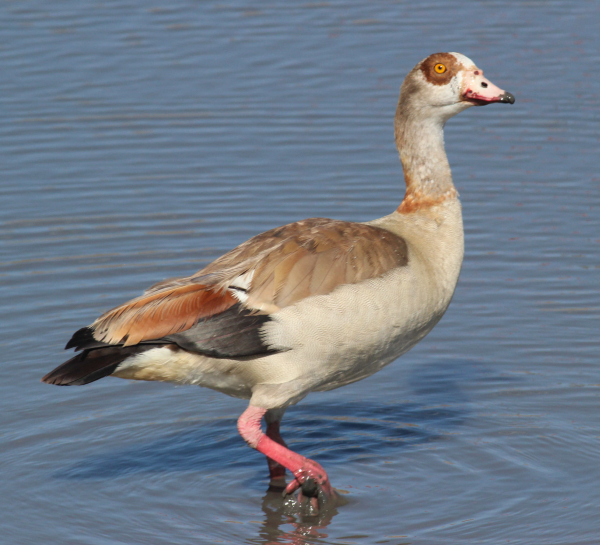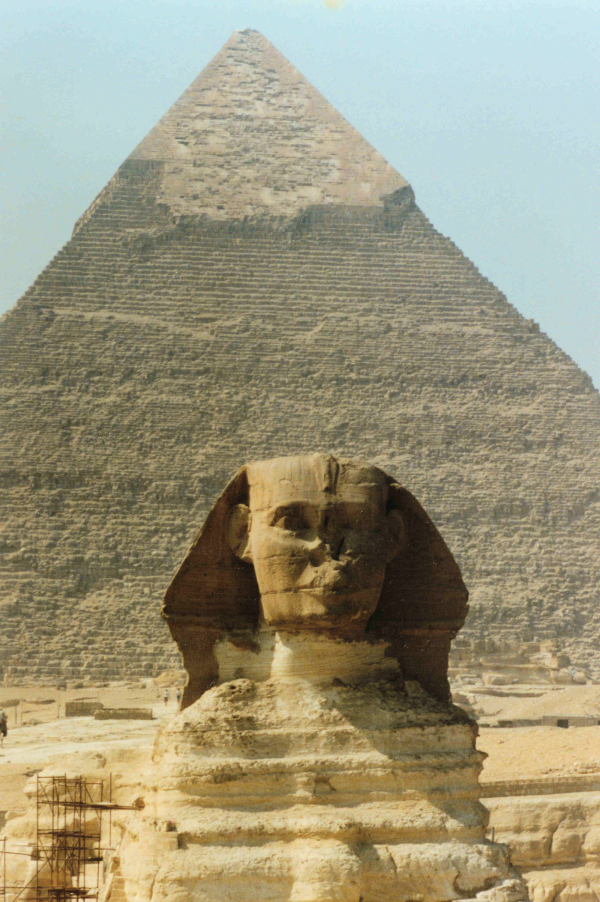
Egyptian Geese, ranging from single birds to large flocks were the dominant waterfowl observed along the Nile River.

The fabled Sphinx framed by the Great Pyramid provides the iconic view of ancient Egypt.

King Tut’s remarkable funerary mask is an enchantingly beautiful artwork beyond its primary intent.
|
Birding in a foreign country is always an adventure, and the excitement of seeing new birds and using a new field guide is hard to beat. I was invited to participate in a cruise of the Nile River to help people identify birds and provide information about the species we encountered along the river and adjoining lands. Sometimes though, local culture, historic buildings and artifacts, and ancient history can overwhelm your wildlife experiences. I must admit that was largely the case in Egypt, where we visited such remarkable historic locations as Giza, Luxor, Karnak, and the fabled Valley of the Kings.
I greatly benefited from the primary focus of the trip – to visit some of the foremost archeological sites in Egypt from Aswan to Cairo, and study the ancient history when pharaohs ruled the region, leaving their temples, statues, reliefs, and tombs for interested tourists, would-be archeologists, and Indiana Jones types to explore. The thrills of hiking among the Pyramids, photographing the Sphinx, descending into Tutankhamen’s tomb, walking through the colossal columns at Karnak and along the Avenue of Sphinxes at the Luxor Temple out-weighed most birding episodes on the trip, but that’s expected when you visit some of the great historic wonders of the world.
As always, I had my binoculars and camera in hand while visiting archaeological sites, and while cruising the storied Nile River. During this memorable trip I identified every bird I saw, tried to photograph as many as possible, and I was always eager to study the behavior of species whenever possible. I especially enjoyed sharing birding experiences with the other passengers on the best observation site, the cruise ship’s open upper deck.
There we could easily view Gray Herons and Little Egrets as they hunted along the banks of the Nile. Pied Kingfishers were almost as abundant as the wading birds, and although we usually observed the kingfishers as single birds or pairs, we also were surprised to see groups of these lively birds numbering up to 18. Other wetland birds included Eurasian Spoonbills, Purple Herons, Spur-winged Plovers, and Black-winged Stilts. Flocks of waterfowl included Egyptian Geese, Ferruginous Ducks, and Eurasian Pochards, along with some duck species common in North America: Northern Pintails and Northern Shovelers. Common birds of prey included Ospreys and Marsh Harriers.
The early Egyptians who built the temples we visited were very aware of the birds that inhabited the Nile Valley, and they even incorporated some species into their ancient religion to signify early gods, including Thoth (the ibis), Nekhbet (the vulture) and others. Most important of all ancient gods was Horus (the falcon), for the ruling pharaohs were said to be the sons of Horus. These and other bird-gods can be seen in the reliefs, statues and obelisks in the temples and tombs of pharaohs, queens, and nobles, along with hieroglyphics of herons, owls, swallows, quail, and other birds.
Few birds inhabit the open desert, but I did find Blue Rock Thrushes, Hooded Wheatears, Pale Crag Martins, and Bar-tailed Desert Larks among the rocks, sand, and ruins. Agricultural areas along the river offered more diversity with Blue-cheeked Bee-eaters, Little Green Bee-eaters, Yellow Wagtails, Hoopoes, Hooded Crows, Black-shouldered Kites, and Eurasian Kestrels among the most memorable species.
The rarest birds I found were Nile Valley Sunbirds, a sleek Sooty Falcon, and a black-morph Montague’s Harrier. While the ship was moored in Luxor, we spent an afternoon birding on Crocodile Island, where I especially enjoyed observing the endemic Nile Valley Sunbirds. These small, active nectar-feeders are especially colorful, with males’ plumage colored gold and iridescent green. Their slightly down-curved bills are typical of this diverse family that is considered to fill a similar Old World niche as our New World hummingbirds.
The cruise ship was a very convenient way to survey the birds of the Nile River in Egypt. The ship also provided an abundance of creature comforts and fine cuisine such as you might expect at a luxury hotel. Fellow cruisers, who hailed from a half-dozen European countries, New Zealand, Canada, and the United States, added much to my Egyptian experiences, as did the many Egyptians who were so eager to show off their historic land. From the ship, in addition to birding, you have an opportunity to view modern life along the Nile River, which sometimes seems to have surpassed the tests of time.
There are so many lasting impressions of Egypt to enjoy and remember, including a desert horseback ride as the sun was setting behind the Pyramids at Giza and photographing the morning action at the old camel market in Cairo with my friend Connie, a surprise visit with Egyptian field guide author and illustrator Sharif Baha el Din, viewing King Tut’s funerary mask – an amazing ancient treasure – along with other archeological artifacts and cultural treasures at the world famous Museum of Egyptian Antiquities; birding through the Valley of the Kings, experiencing historic and modern Karnak and Luxor, sighting a Sooty Falcon flying over the Nile the first morning and watching flock after flock of Egyptian Geese flying from the Nile River across the full moon.
Sometimes, the best birding trips include a lot of personal and non-birding activities, but it all reverts back to a combination of interests, excitement, and surprises – and lots of great birds along the way. Egypt certainly proved to be a crossroads where birds from Europe, the Middle East, and northern Africa criss-cross that ancient land.
Article and photographs by Paul Konrad
Share your birding experiences and photos at editorstbw2@gmail.com